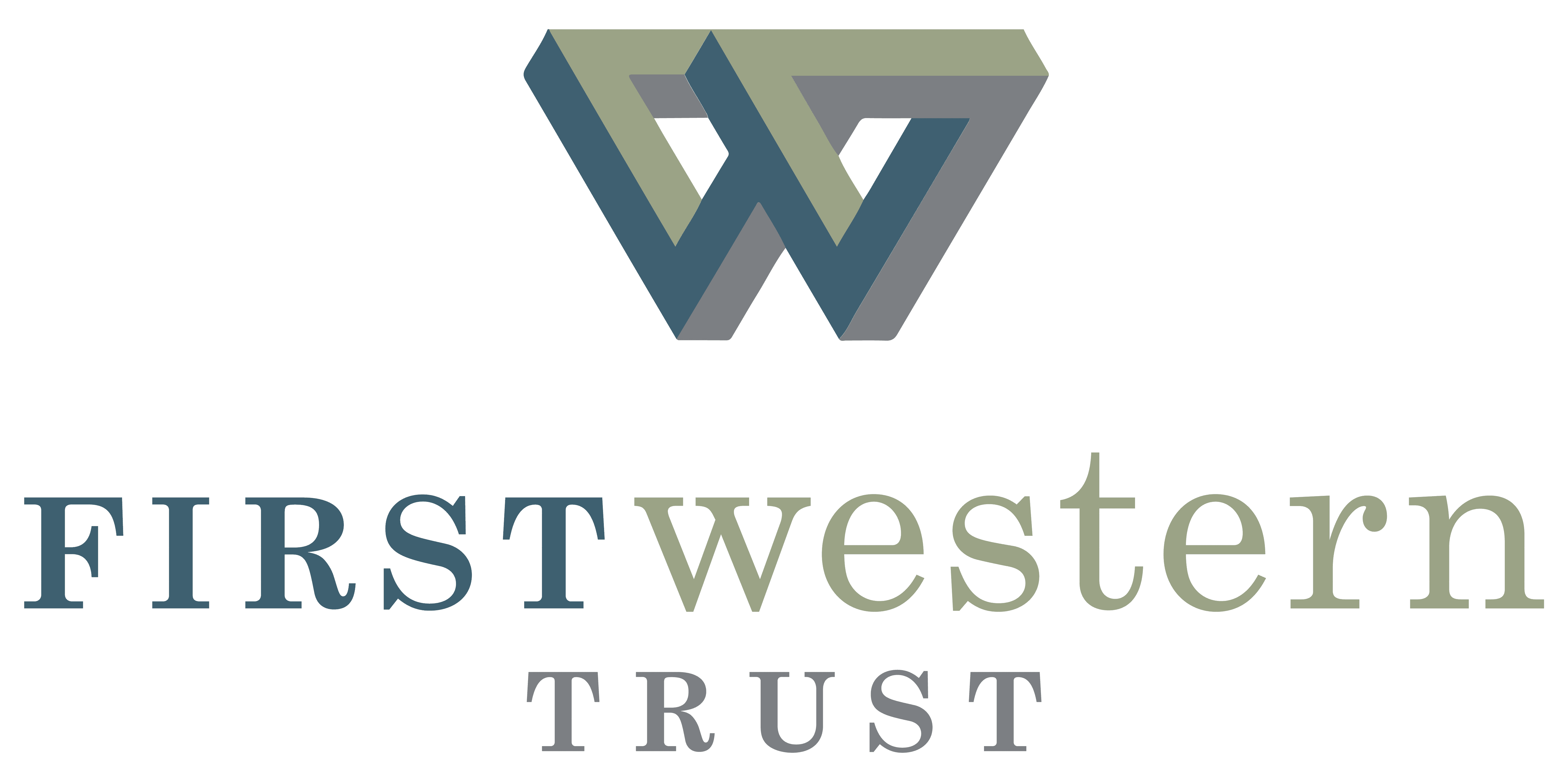
Your Financial Planning Checklist
January 21, 2020
If you’re reading this, you’re already ahead of the curve. You’re doing well, but it’s easy to get scattered. You have brokerage accounts, various IRAs and 401(k)s, insurance policies, CDs, trusts, and any number of other financial accounts — and that’s not to mention vehicles, homes, jewelry, and other assets. What you haven’t done recently is take a broad look at all your finances to take stock of what you have, where you’re going, and what you should do next. That’s where we can help you create a financial planning checklist.
When you work with a financial firm, you want someone that will treat you like an individual. Too many wealth advisor offices are owned by big banks, which means they don’t have much individual time to spend on each client. Instead, they pigeonhole you based on a few numbers about yourself. At First Western Trust, our holistic ConnectView® approach looks at every piece of your financial picture to help you understand how it all fits together.
Our ability to understand your unique situation, and to offer solutions which consider your wealth as a whole, rather than as a single transaction, makes for a powerful combination.
Creating a financial plan — we recommend re-assessing your finances at least every three years, or in the lead up to a major change like the birth of a child, selling a business, or buying a new property — provides the perfect opportunity to look over your assets, liabilities, and other incomes and debts.
Your financial checklist will also include a self-audit of your goals. What are your goals? Have they changed? Are you on track to meet them? It’s never too soon to think about your financial situation going forward.
Take a Personal Financial Inventory
The first step in our ConnectView approach is to truly understand your complete financial situation. You can’t plan what to do with your money unless you know how much you have and where it’s coming from. Every year, you should be taking a look at:
- Assets — make a comprehensive list of all the assets you have on hand, including long-term funds that you don’t intend to spend any time soon. This will include checking and savings accounts, retirement accounts, your emergency fund, other investment and brokerage accounts, real estate, and valuables like cars, artwork, and jewelry.
- Liabilities — do the same for your debts and expenses, including business debts, credit cards, mortgages, and other loan payments.
- Credit Utilization — your credit utilization ratio is simply the amount of debt you’re carrying divided by your total credit limit.
- Insurance portfolio — review your homeowner’s, auto, life, umbrella, long-term care, and any other policies you might have. Make sure you have the coverage you need to avoid risk without paying for overlapping coverage.
Think About Your Financial Goals
Once you have a clear understanding of your personal financial inventory, you can move on to thinking about short-, mid-, and long-term goals.
Short-term goals will take place over the time scale of a year or two. This includes paying off high-interest debts, investment-related goals, and preparing for major changes in your taxes.
Mid-term goals will take you a few years but are worth getting ahead of. They might include setting up a life insurance policy or disability income insurance, buying a new property, moving to a new city, or starting a family.
Long-term goals generally fall into two categories: retirement planning and planning for your legacy. It’s never too early to start thinking about how you wish to retire, and if you have the right plan in place to support your lifestyle down the road.
Retirement planning often involves working backward from the kind of lifestyle you want to have. How much do you want to travel? What kind of monthly income do you want to have available? From there, you can begin to determine a strategy that will support the financial plan you have in mind.
If you’ve already retired, congratulations! But you want to get the most out of the money you’ve set aside in order to retire comfortably, and that takes some planning ahead. Taking stock of the funds you have now and considering how to extend them is a good idea.
Long-term goals will also include what happens to your assets upon your death. If you want your wealth to survive you, you’ll need to plan around trusts, estate taxes, power of attorney, creating a will, and avoiding probate.
Set Family Goals
If you have a spouse or children, you’ll almost certainly have financial goals that are relevant to them. When it comes to children, you might be considering setting up a trust to take care of them, or to set them on a path to reach their own personal or financial goals, so you’ll want to determine how much you need to set aside.
You might also be supporting your parents or other relatives in need of assistance or special care. If that’s the case, it’s worth doing some research into long-term care, medical expenses, and life insurance that can help understand and plan for the costs of doing so.
Finally, when it comes to you and your spouse, you should also be thinking about life insurance plans, your retirement, and the standard of living you want to maintain into your retirement.
Review and Rebalance Your Portfolio
If you’re not a hands-on investor, you’ve probably left the day-to-day of your investments in the hand of a broker or other financial professional. This is a good chance to check in and see how your various investments are performing.
First, check on the way your assets are allocated. Rebalancing your asset portfolio is an important step to ensure that you’re not taking unnecessary risks or holding money within assets or investments which are incurring unnecessary expense or providing you with poor returns. Look at the asset classes you currently have and whether you’re unbalanced in your allocations. You might even consider handing off management of your portfolio to a professional who can give it more granular attention.
Consider Taxes
As Benjamin Franklin said, nothing is certain but death and taxes. You don’t want any unpleasant surprises cropping up as you make your quarterly or annual payments. Before you make major financial moves, consider how they’ll affect your tax strategy.
For example, if you sell off assets, shift your investment portfolio, are looking to set up a charitable trust or make charitable donations, or even provide support or monetary gifts to family members – these are all opportunities to think about developing a tax strategy which allows you to optimize your approach.
Prepare for Emergencies
As you accumulate wealth, you gain the ability to protect yourself, your family, your assets, and your company from risk. Having savings set aside in the form of liquid funds is always a good idea in case of a sudden, large expense, but this is also a good time to take stock of your insurance portfolio.
Health insurance, property insurance, and long-term care insurance are all important pieces of your finances, ensuring that you’re not caught off guard in the case of a disaster. Umbrella insurance can fill in the gaps that your other policies don’t cover, and liability insurance can protect your company from losing significant value.
Make sure you’re covered to an extent that makes you feel comfortable, but look for overlap, too — you don’t need two policies covering the same area of your life.
You’ll also want to be prepared in case of the death of you or your spouse. Make sure you have power of attorney in place — both financial and medical — in case the worst should happen.
A Holistic Approach: ConnectView
Your financial situation is truly only one aspect of your overall wealth. Having financial wealth is certainly beneficial, but at the end of the day – what does your wealth mean to you? At First Western Trust, we know that your wealth isn’t just about dollars and cents — it’s about the life and the experience you’re able to build as a result of that wealth. It’s about your wealth story. That’s why we think of your wealth in four dimensions:
- Financial Wealth – the foundation upon which all of the other facets of your wealth are built. A solid and well-maintained foundation fuels other areas of your wealth story.
- Relational Wealth – the relationships you maintain with family, friends and colleagues; the connection you have between the personal and professional aspects of your life, and the plan used to ensure safety and success in both areas.
- Experiential Wealth – the activities and experiences you engage in to further enrich your life; the way you intend to live out your wealth story, and the plan you use to guide it.
- Legacy Wealth – the culmination of a life well lived; the wealth story you wish to continue beyond your lifetime.
Each of these facets informs and influences the others, and any decision you make in one will have a ripple effect on the rest. Through our proprietary ConnectView® approach, we look at the connections between every investment, real estate holding, trust, or philanthropic endeavor and put your story at the center.
Consult the Professionals
Financial planning is easy to forget about or neglect, and many people can become overwhelmed by everything there is to do and consider. Our experts can help you take the first steps towards a connected view and a plan to make your wealth story a reality. Contact us today to get started!
Newsletter Sign Up
Insights
Week in Review: July 19, 2024
Recap & Commentary A week which began with the S&P 500 and Dow Jones Industrial Average setting new record highs, […]
Learn more
Fraud Prevention Strategies for Businesses
Fraud is a significant threat to small businesses. According to the Association of Certified Fraud Examiners (ACFE), fraud losses cost […]
Learn more
Week in Review: July 12, 2024
Recap & Commentary Markets ended the week higher with the S&P 500 and NASDAQ setting new records along the way. […]
Learn more
Top Investment Trends For 2024
As January 2023 began, the American economy faced significant challenges from inflation and rising interest rates. These pressures intensified as […]
Learn more
June 2024 Market Commentary
The saying “April showers bring May flowers” can be traced to an English poet from the 1500s. Today, the quote […]
Learn more








